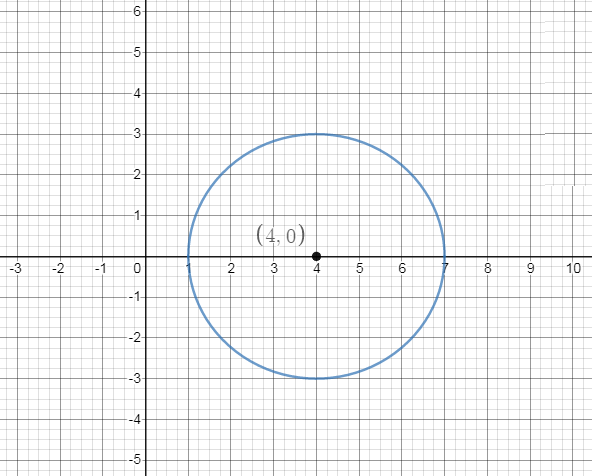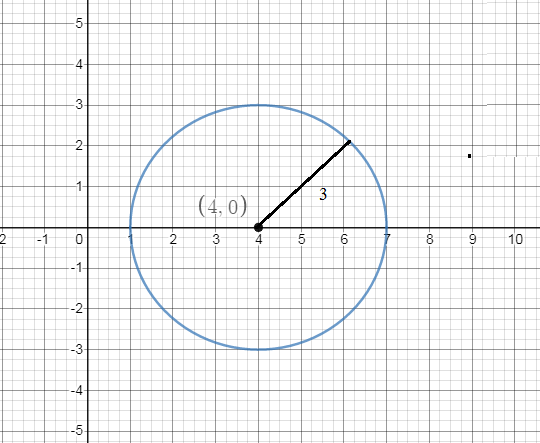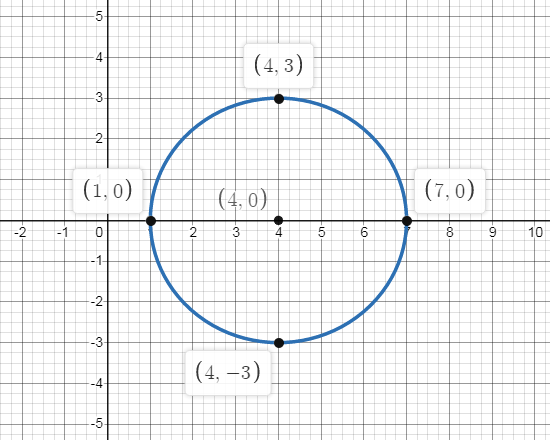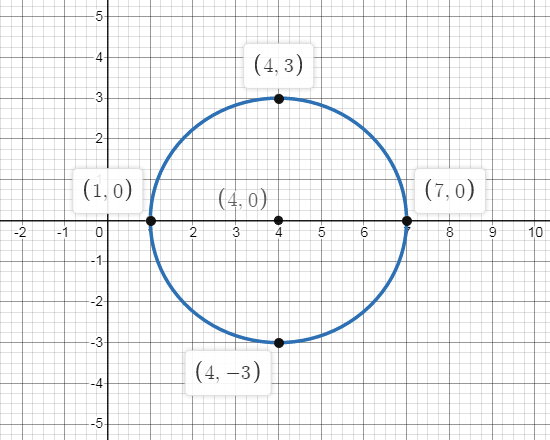
How do you graph the circle with center at \[\left( {4,0} \right)\] and radius 3 and label the center and at least four points on the circle, then write the equation of the circle?
Answer
534k+ views
Hint: In this question we are asked to plot the circle with centre and radius given, We first Plot the center of the circle at \[\left( {h,k} \right)\] and then count out from the center \[r\] units in the four directions (up, down, left, and right). Then, connect those four points with a nice, round circle, and here \[h = 4\], \[k = 0\], and \[r = 3\] substitute the center and radius in the standard form of equation of circle which is given by \[{\left( {x - h} \right)^2} + {\left( {y - k} \right)^2} = {r^2}\].
Complete step by step solution:
A circle is the set of all points the same distance from a given point, the center of the circle. A radius, \[r\], is the distance from that center point to the circle itself.
Now plotting the circle on the graph,
Given center \[\left( {4,0} \right)\] and radius 3,
Place the center of the circle at \[\left( {4,0} \right)\], which is shown in the figure below,

Plot the radius points on the coordinate plane, which is given as 3,

Now count 3 units up, down, left, and right from the center at \[\left( {4,0} \right)\]to plot the four points on the circle
Count 3 units right, i.e., add 3 units to the \[x\]-coordinate of the center we get,
\[ \Rightarrow \left( {4 + 3,0 + 0} \right) = \left( {7,0} \right)\],
Now count 3 units left i.e., subtract 3 units from the \[x\]-coordinate of the center we get,
\[ \Rightarrow \left( {4 - 3,0 + 0} \right) = \left( {1,0} \right)\],
Now count 3 units up, i.e., add 3 units to the \[y\]-coordinate of the center we get,
\[ \Rightarrow \left( {4 + 0,0 + 3} \right) = \left( {4,3} \right)\],
Now count 3 units down, subtract 3 units to the \[y\]-coordinate of the center we get,\[ \Rightarrow \left( {4 + 0,0 - 3} \right) = \left( {4, - 3} \right)\],
This means that we should have points at, \[\left( {7,0} \right)\], \[\left( {1,0} \right)\], \[\left( {4,3} \right)\] and \[\left( {4, - 3} \right)\].
Connect the dots to the graph of the circle with a round, smooth curve.

Now we know that the equation of circle with center \[\left( {h,k} \right)\]and radius \[r\]is given by \[{\left( {x - h} \right)^2} + {\left( {y - k} \right)^2} = {r^2}\], so here center \[\left( {4,0} \right)\] and radius 3, substituting the values in the equation we get,
\[ \Rightarrow {\left( {x - 4} \right)^2} + {\left( {y - 0} \right)^2} = {3^2}\],
Now simplifying we get,
\[ \Rightarrow {\left( {x - 4} \right)^2} + {y^2} = 9\].
So, the equation of the circle is \[{\left( {x - 4} \right)^2} + {y^2} = 9\].
\[\therefore \] The required graph for the circle with center \[\left( {4,0} \right)\]and radius 3 will be shown as,

and the equation of circle with center \[\left( {4,0} \right)\]and radius 3 will be equal to\[{\left( {x - 4} \right)^2} + {y^2} = 9\].
Note:
Graphing circles requires two things: the coordinates of the center point, and the radius of a circle. While plotting the circle on the graph we have to remember to switch the sign of the \[h\] and \[k\]from inside the parentheses in the equation. This is necessary because the \[h\] and \[k\] are inside the grouping symbols, which means that the shift happens opposite from what we would think.
Complete step by step solution:
A circle is the set of all points the same distance from a given point, the center of the circle. A radius, \[r\], is the distance from that center point to the circle itself.
Now plotting the circle on the graph,
Given center \[\left( {4,0} \right)\] and radius 3,
Place the center of the circle at \[\left( {4,0} \right)\], which is shown in the figure below,

Plot the radius points on the coordinate plane, which is given as 3,

Now count 3 units up, down, left, and right from the center at \[\left( {4,0} \right)\]to plot the four points on the circle
Count 3 units right, i.e., add 3 units to the \[x\]-coordinate of the center we get,
\[ \Rightarrow \left( {4 + 3,0 + 0} \right) = \left( {7,0} \right)\],
Now count 3 units left i.e., subtract 3 units from the \[x\]-coordinate of the center we get,
\[ \Rightarrow \left( {4 - 3,0 + 0} \right) = \left( {1,0} \right)\],
Now count 3 units up, i.e., add 3 units to the \[y\]-coordinate of the center we get,
\[ \Rightarrow \left( {4 + 0,0 + 3} \right) = \left( {4,3} \right)\],
Now count 3 units down, subtract 3 units to the \[y\]-coordinate of the center we get,\[ \Rightarrow \left( {4 + 0,0 - 3} \right) = \left( {4, - 3} \right)\],
This means that we should have points at, \[\left( {7,0} \right)\], \[\left( {1,0} \right)\], \[\left( {4,3} \right)\] and \[\left( {4, - 3} \right)\].
Connect the dots to the graph of the circle with a round, smooth curve.

Now we know that the equation of circle with center \[\left( {h,k} \right)\]and radius \[r\]is given by \[{\left( {x - h} \right)^2} + {\left( {y - k} \right)^2} = {r^2}\], so here center \[\left( {4,0} \right)\] and radius 3, substituting the values in the equation we get,
\[ \Rightarrow {\left( {x - 4} \right)^2} + {\left( {y - 0} \right)^2} = {3^2}\],
Now simplifying we get,
\[ \Rightarrow {\left( {x - 4} \right)^2} + {y^2} = 9\].
So, the equation of the circle is \[{\left( {x - 4} \right)^2} + {y^2} = 9\].
\[\therefore \] The required graph for the circle with center \[\left( {4,0} \right)\]and radius 3 will be shown as,

and the equation of circle with center \[\left( {4,0} \right)\]and radius 3 will be equal to\[{\left( {x - 4} \right)^2} + {y^2} = 9\].
Note:
Graphing circles requires two things: the coordinates of the center point, and the radius of a circle. While plotting the circle on the graph we have to remember to switch the sign of the \[h\] and \[k\]from inside the parentheses in the equation. This is necessary because the \[h\] and \[k\] are inside the grouping symbols, which means that the shift happens opposite from what we would think.
Recently Updated Pages
A man running at a speed 5 ms is viewed in the side class 12 physics CBSE

The number of solutions in x in 02pi for which sqrt class 12 maths CBSE

State and explain Hardy Weinbergs Principle class 12 biology CBSE

Write any two methods of preparation of phenol Give class 12 chemistry CBSE

Which of the following statements is wrong a Amnion class 12 biology CBSE

Differentiate between action potential and resting class 12 biology CBSE

Trending doubts
What are the major means of transport Explain each class 12 social science CBSE

Which are the Top 10 Largest Countries of the World?

Draw a labelled sketch of the human eye class 12 physics CBSE

Explain sex determination in humans with line diag class 12 biology CBSE

Explain sex determination in humans with the help of class 12 biology CBSE

Differentiate between homogeneous and heterogeneous class 12 chemistry CBSE




